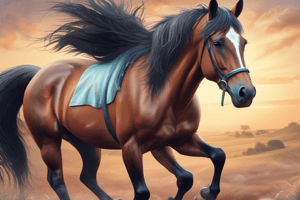Podcast
Questions and Answers
Match the following key areas of focus in veterinary science with their descriptions:
Match the following key areas of focus in veterinary science with their descriptions:
Monitoring the health of food animals = Regular check-ups and health assessments for livestock and farm animals Conducting ante-mortem inspections of animals = Evaluating animals for signs of diseases or conditions before they die Performing post-mortem inspections of carcasses and meat = Examining animal bodies after death to determine causes of death Inspecting fish, milk, and other food products of animal origin to ensure safety = Ensuring that food products derived from animals meet safety standards
Match the following tasks in veterinary science with their purposes:
Match the following tasks in veterinary science with their purposes:
Providing counseling to owners of pets, livestock, and other animals on proper care = Educating animal owners on how to properly care for their animals Contributing to wildlife conservation efforts = Participating in initiatives to protect and preserve wildlife species Diagnosing and identifying diseases or conditions = Determining the specific illnesses affecting animals through scientific evaluation Treating diseases through medications, surgical procedures, and physical therapy = Using various methods to address the cause and symptoms of animal diseases
Match the following treatment approaches in veterinary science with their goals:
Match the following treatment approaches in veterinary science with their goals:
Eliminating the cause, symptoms, and effects of diseases = Targeting all aspects of the disease for a comprehensive cure Providing palliative care = Focusing on symptom management and improving quality of life in terminal cases Control and prevention strategies = Implementing measures to stop the spread of diseases among animals or regions Thorough scientific evaluation including history, physical examinations, and laboratory tests = Conducting a detailed assessment to diagnose diseases or conditions accurately
Match the following preventive measures in veterinary science with their purposes:
Match the following preventive measures in veterinary science with their purposes:
Match the following diagnostic methods in veterinary science with their descriptions:
Match the following diagnostic methods in veterinary science with their descriptions:
Match the following treatment options in veterinary science with their goals:
Match the following treatment options in veterinary science with their goals:
Match the following counseling areas in veterinary science with their focus:
Match the following counseling areas in veterinary science with their focus:
Match the following inspection activities in veterinary science with their objectives:
Match the following inspection activities in veterinary science with their objectives:
Match the following key areas of focus in veterinary science with their descriptions:
Match the following key areas of focus in veterinary science with their descriptions:
Match the following activities in veterinary science with their purposes:
Match the following activities in veterinary science with their purposes:
Match the following treatment approaches in veterinary science with their goals:
Match the following treatment approaches in veterinary science with their goals:
Match the following control and prevention strategies in veterinary science with their purposes:
Match the following control and prevention strategies in veterinary science with their purposes:
Flashcards are hidden until you start studying




